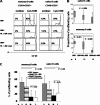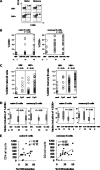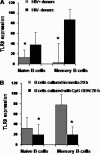Impaired naive and memory B-cell responsiveness to TLR9 stimulation in human immunodeficiency virus infection
- PMID: 18524824
- PMCID: PMC2519583
- DOI: 10.1128/JVI.00660-08
Impaired naive and memory B-cell responsiveness to TLR9 stimulation in human immunodeficiency virus infection
Abstract
Toll-like receptor 9 (TLR9) agonists such as unmethylated bacterial CpG DNAs activate B lymphocytes directly, potentially influencing their function and homeostasis. To assess B-cell responsiveness to TLR9 agonists in human immunodeficiency virus (HIV) disease, we examined the ability of naive and memory B cells to proliferation and to increase surface expression of CD80 in response to CpG oligonucleotides (ODN). CpG ODN induced expression of CD80 similarly in B cells from HIV-infected persons and from healthy controls. In contrast, proliferation responses to CpG ODN were markedly impaired in both naive and memory B-cell subsets from HIV-infected persons. Naive B-cell proliferation defects were related to plasma HIV RNA and, among memory B cells, to the frequencies of CD21-negative cells. Importantly, TLR9 mRNA levels were significantly diminished in freshly prepared naive B cells and especially so in memory B cells from HIV-positive viremic donors, suggesting a possible underlying mechanism for the observed functional impairments. Dose-response studies indicated that optimal induction of CD80 expression was achieved with much lower concentrations of CpG ODN than optimal induction of proliferation. We propose that the relatively low threshold of activation that is required for CD80 induction by CpG ODN might explain the preservation of this response in B cells from HIV-infected persons despite diminished TLR9 expression. Impaired responsiveness to TLR9 agonists may contribute to defects in humoral immunity in HIV infection.
Figures






References
-
- Agematsu, K. 2000. Memory B cells and CD27. Histol. Histopathol. 15573-576. - PubMed
-
- Bernasconi, N. L., E. Traggiai, and A. Lanzavecchia. 2002. Maintenance of serological memory by polyclonal activation of human memory B cells. Science 2982199-2202. - PubMed
-
- Bernasconi, N. L., N. Onai, and A. Lanzavecchia. 2003. A role for Toll-like receptors in acquired immunity: up-regulation of TLR9 by BCR triggering in naive B cells and constitutive expression in memory B cells. Blood 1014500-4504. - PubMed
-
- Bourke, E., D. Bosisio, J. Golay, N. Polentarutti, and A. Mantovani. 2003. The toll-like receptor repertoire of human B lymphocytes: inducible and selective expression of TLR9 and TLR10 in normal and transformed cells. Blood 102956-963. - PubMed
-
- Brenchley, J. M., D. A. Price, T. W. Schacker, T. E. Asher, G. Silvestri, S. Rao, Z. Kazzaz, E. Bornstein, O. Lambotte, D. Altmann, B. R. Blazar, B. Rodriguez, L. Teixeira-Johnson, A. Landay, J. N. Martin, F. M. Hecht, L. J. Picker, M. M. Lederman, S. G. Deeks, and D. C. Douek. 2006. Microbial translocation is a cause of systemic immune activation in chronic HIV infection. Nat. Med. 121365-1371. - PubMed
Publication types
MeSH terms
Substances
Grants and funding
LinkOut - more resources
Full Text Sources
Medical

